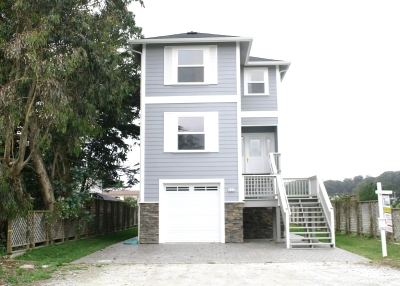We don’t have to build on every substandard lot

Reprinted with permission from the current issue of Green Footnotes, the newsletter of the Committee for Green Foothills.
Thousands of lots—smaller than today’s standard lots—were created in the first decade of the 20th Century. If all these lots were developed, it would create a serious burden on the Midcoast’s infrastructure. But two recent court rulings show the way to solving the substandard lot problem.
The San Mateo Coastside experienced a tremendous real estate boom, spurred on by the construction of the Ocean Shore Railroad. San Francisco capitalists and land speculators promoted the railroad as easy transport to coastal resorts – and to inexpensive home sites. In just a few years, over 55 housing tracts were laid out along the route between San Francisco and Santa Cruz.
These old tracts were paper artifacts – grids of streets and lots drawn on a map without provision for other necessary improvements such as sidewalks, drainage, and utilities. Some of these paper streets and lots were located atop creeks, cliffs and bluffs; in fact, the eponymous Ocean Boulevard, a "paper street" in Princeton by the Sea that was never constructed, is now under water.
The Ocean Shore Railroad only operated for 13 years, but its legacy of antiquated subdivisions continues to plague County planners and decision-makers today. Several of these old subdivisions are composed of thousands of 25-foot by 100-foot lots, which do not meet today’s minimum zoning standards of 5,000 square feet.
San Mateo County has struggled for many years with the thorny issue of how to treat these tiny, substandard lots. Many are still undeveloped, and are still in common ownership. If each substandard lot were developed separately, the Midcoast area’s limited infrastructure, especially roads, sewer, and water, would be overwhelmed, and its semi- rural ambiance would be lost.
Two recent Court of Appeal decisions (Witt Home Ranch, Inc. v. County of Sonoma (2008) and Abernathy Valley, Inc. v. County of Solano (2009)), have clarified the legal status of lots that were "created" by these ancient subdivision maps and are still in common ownership.
San Mateo County Counsel Mike Murphy recently advised the Board of Supervisors that any owner of contiguous lots who wishes to develop will need to demonstrate through a "chain of title" or history of the deeds whether each of the lots was sold or conveyed separately to different owners. If so, they will likely be acknowledged as separate legal parcels. If the lots were always sold or conveyed as one unit, the owner likely has only one legal parcel. If that parcel is larger than the minimum allowed in the zoning district, and complies with all other applicable zoning requirements, it likely can be subdivided.
The Witt and Abernathy court decisions add new steps for owners who wish to develop, but also provide an opportunity for local governments to ensure that these legacies of the past conform to modern-day land use planning principles.
